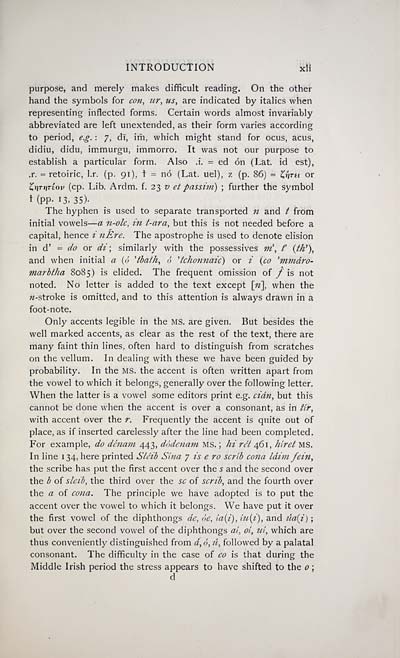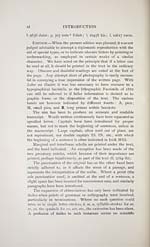Download files
Complete book:
Individual page:
Thumbnail gallery: Grid view | List view

INTRODUCTION xli
purpose, and merely makes difficult reading. On the other
hand the symbols for con, ur, us, are indicated by italics when
representing inflected forms. Certain words almost invariably
abbreviated are left unextended, as their form varies according
to period, e.g. : 7, dl, irh, which might stand for ocus, acus,
didiu, didu, immurgu, immorro. It was not our purpose to
establish a particular form. Also .i. = ed on (Lat. id est),
,r. = retoiric, l.r. (p. 91), í = nó (Lat. uel), z (p. 86) = Zj\rti or
Zi]ti]tíov (cp. Lib. Ardm. f. 23 v et passim) ; further the symbol
t (PP- 13, 35)-
The hyphen is used to separate transported n and t from
initial vowels — a n-olc, in t-ara, but this is not needed before a
capital, hence i nEre. The apostrophe is used to denote elision
in d' = do or di ; similarly with the possessives m\ f (tá'),
and when initial a {6 Hbath, 6 , tchon?iaic) or i (co 'mmáro-
marbtha 8085) is elided. The frequent omission of f is not
noted. No letter is added to the text except [n], when the
«-stroke is omitted, and to this attention is always drawn in a
foot-note.
Only accents legible in the MS. are given. But besides the
well marked accents, as clear as the rest of the text, there are
many faint thin lines, often hard to distinguish from scratches
on the vellum. In dealing with these we have been guided by
probability. In the MS. the accent is often written apart from
the vowel to which it belongs, generally over the following letter.
When the latter is a vowel some editors print e.g. cidn, but this
cannot be done when the accent is over a consonant, as in Ur,
with accent over the r. Frequently the accent is quite out of
place, as if inserted carelessly after the line had been completed.
For example, do dcnam 443, dódenám MS. ; hi rét 461, hiret MS.
In line 134, here printed Slc'ib Sina 7 is e ro scrib cona Idim fein,
the scribe has put the first accent over the s and the second over
the b of sleib, the third over the sc of scrib, and the fourth over
the a of cona. The principle we have adopted is to put the
accent over the vowel to which it belongs. We have put it over
the first vowel of the diphthongs de, óe, ía(i'), íu(i), and úa(i) ;
but over the second vowel of the diphthongs at, ol, id, which are
thus conveniently distinguished from d, 6, u, followed by a palatal
consonant. The difficulty in the case of eo is that during the
Middle Irish period the stress appears to have shifted to the ;
d
purpose, and merely makes difficult reading. On the other
hand the symbols for con, ur, us, are indicated by italics when
representing inflected forms. Certain words almost invariably
abbreviated are left unextended, as their form varies according
to period, e.g. : 7, dl, irh, which might stand for ocus, acus,
didiu, didu, immurgu, immorro. It was not our purpose to
establish a particular form. Also .i. = ed on (Lat. id est),
,r. = retoiric, l.r. (p. 91), í = nó (Lat. uel), z (p. 86) = Zj\rti or
Zi]ti]tíov (cp. Lib. Ardm. f. 23 v et passim) ; further the symbol
t (PP- 13, 35)-
The hyphen is used to separate transported n and t from
initial vowels — a n-olc, in t-ara, but this is not needed before a
capital, hence i nEre. The apostrophe is used to denote elision
in d' = do or di ; similarly with the possessives m\ f (tá'),
and when initial a {6 Hbath, 6 , tchon?iaic) or i (co 'mmáro-
marbtha 8085) is elided. The frequent omission of f is not
noted. No letter is added to the text except [n], when the
«-stroke is omitted, and to this attention is always drawn in a
foot-note.
Only accents legible in the MS. are given. But besides the
well marked accents, as clear as the rest of the text, there are
many faint thin lines, often hard to distinguish from scratches
on the vellum. In dealing with these we have been guided by
probability. In the MS. the accent is often written apart from
the vowel to which it belongs, generally over the following letter.
When the latter is a vowel some editors print e.g. cidn, but this
cannot be done when the accent is over a consonant, as in Ur,
with accent over the r. Frequently the accent is quite out of
place, as if inserted carelessly after the line had been completed.
For example, do dcnam 443, dódenám MS. ; hi rét 461, hiret MS.
In line 134, here printed Slc'ib Sina 7 is e ro scrib cona Idim fein,
the scribe has put the first accent over the s and the second over
the b of sleib, the third over the sc of scrib, and the fourth over
the a of cona. The principle we have adopted is to put the
accent over the vowel to which it belongs. We have put it over
the first vowel of the diphthongs de, óe, ía(i'), íu(i), and úa(i) ;
but over the second vowel of the diphthongs at, ol, id, which are
thus conveniently distinguished from d, 6, u, followed by a palatal
consonant. The difficulty in the case of eo is that during the
Middle Irish period the stress appears to have shifted to the ;
d
Set display mode to: Large image | Transcription
Images and transcriptions on this page, including medium image downloads, may be used under the Creative Commons Attribution 4.0 International Licence unless otherwise stated. ![]()
| Early Gaelic Book Collections > Matheson Collection > Lebor na huidre > (45) |
|---|
| Permanent URL | https://digital.nls.uk/80088817 |
|---|
| Description | Items from a collection of 170 volumes relating to Gaelic matters. Mainly philological works in the Celtic and some non-Celtic languages. Some books extensively annotated by Angus Matheson, the first Professor of Celtic at Glasgow University. |
|---|
| Description | Selected items from five 'Special and Named Printed Collections'. Includes books in Gaelic and other Celtic languages, works about the Gaels, their languages, literature, culture and history. |
|---|

